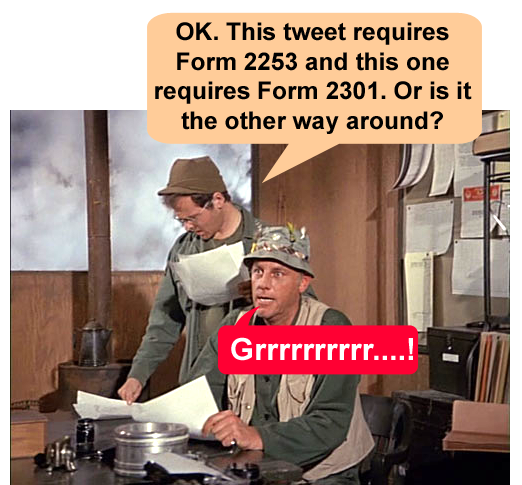The FDA just issued “Guidance for Industry Fulfilling Regulatory Requirements for Postmarketing Submissions of Interactive Promotional Media for Prescription Human and Animal Drugs and Biologics.”
You can find it here.
“This draft guidance describes FDA’s current thinking on what the Agency considers to be interactive promotional media and outlines the considerations taken into account in determining if product communications using interactive technologies are subject to FDA’s postmarketing submission requirements. Furthermore, this draft guidance provides FDA’s recommendations for how firms can fulfill the regulatory requirement to submit postmarketing promotional materials to the FDA in a practical manner to address the potential volume of real-time information that is continuously posted and shared through various interactive promotional media platforms.”
Usually, drug companies must submit every promotional piece — print ad, TV ad, or drug.com web page — to the FDA at the time of “initial dissemination” (e.g., when the TV ad first airs). “However,” says FDA, “for some interactive promotional media, submission ‘at the time of initial dissemination’ may pose a challenge for firms, particularly when these media communicate information that is displayed in real time.”
This may sound like the much-anticipated guidance for how the FDA will regulate drug promotion on the Internet and social media sites, but it really describes when and how pharma companies should submit forms to the FDA to fulfill regulatory requirements for post marketing submissions. Nevertheless, it does give us some insight into FDA’s thinking about how it intends to regulate interactive promotions
I’ll just summarize what I consider to be a few interesting comments made in this draft guidance.
FDA acknowledges for perhaps the first time that interactive media “possess certain unique technological features and offer novel presentation and content features” that set them apart from traditional media such as print:
“Although some interactive promotional media are substantially similar in presentation and content to certain traditional promotional media, such as print media, FDA recognizes that in other cases they possess certain unique technological features and offer novel presentation and content features.”
This is contrary to the mantra “FDA is media agnostic” that I’ve been hearing for years. I’ve pointed out before that the FDA is definitely not “media agnostic” (see “FDA Rules are NOT Media Agnostic“).
If the FDA feels that interactive media requires special guidelines for submission of forms, then it should also feel that special guidelines are required for how it intends to regulate drug promotions disseminated via interactive media.
FDA acknowledges that a drug firm is responsible for product promotional communications on sites that are “owned, controlled, created, influenced, or operated by, or on behalf of, the firm. Such product promotional communications may include firm-sponsored microblogs (e.g., Twitter), social networking sites (e.g., Facebook), firm blogs, and other sites that are under the control or influence of the firm.”
This is interesting because I have often wondered if drug firms have submitted branded tweets — such as the infamous Levimir tweet (here) — to the FDA.
Despite the fact that the term UGC (user-generated content) is out of date in this world where 90% of what’s online is user-generated, FDA has a lot to say about UGC in this draft guidance. As in:
- “a firm is responsible for UGC and communications of its employees or anyone acting on behalf of the firm and, as such, those materials are subject to submission to FDA to meet the postmarketing submission requirements.”
- “FDA will not ordinarily view UGC on firm-owned or firm-controlled venues such as blogs, message boards, and chat rooms as promotional content on behalf of the firm as long as the user has no affiliation with the firm and the firm had no influence on the UGC.”
- If “a firm does not have any control of, or influence on, information on an independent third party site but chooses to promote its product on this site (e.g., by providing specific promotional content such as firm-initiated UGC). In this situation, to meet postmarketing submission requirements, the firm is responsible for submitting to FDA the promotional content it provided to the site.
“Under certain circumstances,” says FDA, “a firm is responsible for promotion on third-party sites.” FDA cites this example:
“A firm does not have any control of, or influence on, information on an independent third-party site but chooses to promote its product on this site (e.g., by providing specific promotional content such as firm-initiated UGC). In this situation, to meet postmarketing submission requirements, the firm is responsible for submitting to FDA the promotional content it provided to the site.”
FDA mentions “firm-initiated UGC” but can this also apply to regular display ads or promotional banners? I imagine that drug firms would make arrangements to place such ads in prominent positions on third-party sites. Does the FDA require the firm to submit forms not only for the ad itself but also for all the pages on which the ad may appear?
I must admit that the rules (“principles”) for submitting forms presented on the last two pages of the guidance are confusing. Perhaps someone with a better compliance background can explain these principles to me.
Anyway, that’s all for now.
UPDATE (3 FEB 2014): “FDA’s 2014 Social Media Guidance Agenda Published: Space Limitation, Correcting Third Party Misinformation, & Use of Links Included“









![6 Digital Tools at the Center of Healthcare Digitalization [INFOGRAPHIC]](http://ec2-54-175-84-28.compute-1.amazonaws.com/pharma-mkting.com/wp-content/uploads/2021/04/6DigitalTools_600px-100x70.jpg)




